Related Research Articles
The Puebloans or Pueblo peoples, are Native Americans in the Southwestern United States who share common agricultural, material, and religious practices. Pueblo, which means "village" in Spanish, was a term originating with the Colonial Spanish, who used it to refer to the people's particular style of dwelling.
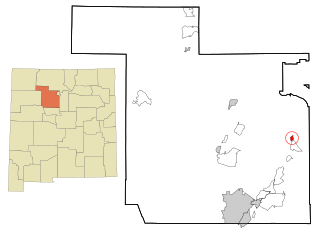
Cochiti is a census-designated place (CDP) in Sandoval County, New Mexico, United States. A historic pueblo of the Cochiti people, it is part of the Albuquerque Metropolitan Statistical Area. The population was 528 at the 2010 census. Located 22 miles (35 km) southwest of Santa Fe, the community is listed as a historic district on the National Register of Historic Places.

San Felipe Pueblo is a census-designated place (CDP) in Sandoval County, New Mexico, United States, and is located 10 miles (16 km) north of Bernalillo. As of the 2000 census, the CDP population was 2,080. It is part of the Albuquerque Metropolitan Statistical Area. The Pueblo, founded in 1706, comprises Native Americans who speak an eastern dialect of the Keresan languages.

Kewa Pueblo, formerly known as Santo Domingo Pueblo, is a census-designated place (CDP) in Sandoval County, New Mexico, United States and a federally recognized tribe of Native American Pueblo people.
Tiwa is a group of two, possibly three, related Tanoan languages spoken by the Tiwa Pueblo, and possibly Piro Pueblo, in the U.S. state of New Mexico.
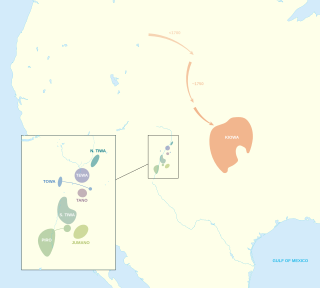
Tanoan, also Kiowa–Tanoan or Tanoan–Kiowa, is a family of languages spoken by indigenous peoples in present-day New Mexico, Kansas, Oklahoma, and Texas.
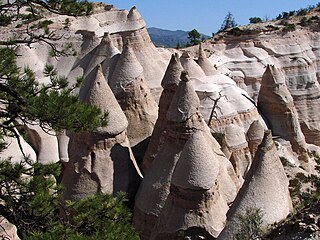
Kasha-Katuwe Tent Rocks National Monument is a U.S. National Monument located approximately 40 miles (64 km) southwest of Santa Fe, New Mexico, near Cochiti Pueblo. Managed by the Bureau of Land Management (BLM), it was established as a U.S. National Monument by President Bill Clinton in January 2001. Kasha-Katuwe means "white cliffs" in the Pueblo language Keresan. The monument is a unit of the BLM's National Conservation Lands.

Zuni is a language of the Zuni people, indigenous to western New Mexico and eastern Arizona in the United States. It is spoken by around 9,500 people in total, especially in the vicinity of Zuni Pueblo, New Mexico, and much smaller numbers in parts of Arizona.
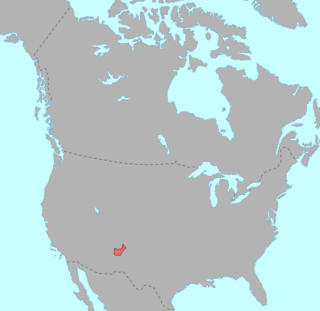
Keresan, also Keres, is a Native American language, spoken by the Keres Pueblo people in New Mexico. Depending on the analysis, Keresan is considered a small language family or a language isolate with several dialects. The varieties of each of the seven Keres pueblos are mutually intelligible with its closest neighbors. There are significant differences between the Western and Eastern groups, which are sometimes counted as separate languages.
Tewa is a Tanoan language spoken by Pueblo people, mostly in the Rio Grande valley in New Mexico north of Santa Fe, and in Arizona. It is also known as Tano, or (archaic) Tée-wah.
Chakwaina is a kachina which appears in Hopi, Zuni, and Keresan ceremonies, but does not appear in Tewa ceremonies. Although imagery of the kachina is varied, it is usually depicted as an ogre, with ferocious teeth and a black goatee and black mask with yellow eyes. Its spread throughout Pueblo culture is often associated with the Asa clan.
Pueblo music includes the music of the Hopi, Zuni, Taos Pueblo, San Ildefonso, Santo Domingo, and many other Puebloan peoples, and according to Bruno Nettl features one of the most complex Native American musical styles on the continent. Characteristics include common use of hexatonic and heptatonic scales, variety of form, melodic contour, and percussive accompaniment, melodic range averaging between an octave and a twelfth, with rhythmic complexity equal to the Plains Indians musical sub-area.
Mateo Romero is a Native American painter. He was born in Berkeley, California, and is a member of the Cochiti Pueblo.
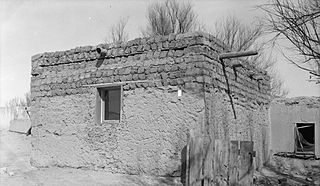
Pueblo of Isleta or Isleta Pueblo is an unincorporated community and Tanoan pueblo in Bernalillo County, New Mexico, United States, originally established in the c. 14th century. The Southern Tiwa name of the pueblo is Shiewhibak (Shee-eh-whíb-bak) meaning "a knife laid on the ground to play whib", a traditional footrace. Its people are a federally recogized tribe.

The Laguna Pueblo is a federally recognized tribe of Native American Pueblo people in west-central New Mexico, near the city of Albuquerque, in the United States. Part of the Laguna territory is included in the Albuquerque metropolitan area, chiefly around Laguna's Route 66 Resort and Casino. The name, Laguna, is Spanish and derives from the lake on their reservation. This body of water was formed by an ancient dam that was constructed by the Laguna people. After the Pueblo Revolt of 1680–1696, the Mission San José de la Laguna was erected by the Spanish at the old pueblo and finished around July 4, 1699.
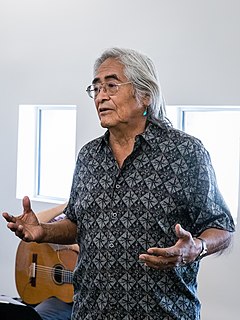
Simon J. Ortiz is a Puebloan writer of the Acoma Pueblo tribe, and one of the key figures in the second wave of what has been called the Native American Renaissance. He is one of the most respected and widely read Native American poets. Ortiz's commitment to preserving and expanding the literary and oral traditions of the Acoma accounts for many of the themes and techniques that compose his work. Ortiz identifies himself less as a "poet" than a "storyteller". The composition of a traditional Pueblo storyteller includes not only oral narrative materials, which adapt easily to short story or essay forms, but also songs, chants, winter stories, sacred oral narratives associated with origin stories and their attendant ceremonies. Such materials when recited aloud, have a distinctly "poetic" texture.

Solomon Bibo was a Jewish trader in the American Old West who became governor of Acoma Pueblo, equivalent of the tribal chief. He was the only non-Indian ever to serve as a governor of an Indian Pueblo.
The Pueblo linguistic area is a Sprachbund consisting of the languages spoken in and near North American Pueblo locations. There are also many shared cultural practices in this area. For example, these cultures share many ceremonial vocabulary terms meant for prayer or song.
Heishe or heishi are small disc- or tube-shaped beads made of organic shells or ground and polished stones. They come from the Kewa Pueblo people of New Mexico, before the use of metals in jewelry by that people. The name is the word for shell bead in the Eastern Keresan language of the Santo Domingo Indians.
The Keres people are one of the Pueblo peoples. They speak English, Keresan languages, and in one pueblo Keresan Sign Language.
References
- ↑ Kelley, Walter & Tony McGregor (2003) "Keresan Pueblo Indian Sign Language", in Reyhner, Trujillo, Carrasco, & Lockard (eds.), Nurturing Native Languages, pp. 141–148. Flagstaff: Northern Arizona University.
- ↑ Hammarström, Harald; Forkel, Robert; Haspelmath, Martin, eds. (2017). "Keresan Pueblo Indian Sign Language". Glottolog 3.0 . Jena, Germany: Max Planck Institute for the Science of Human History.
| This article about a sign language or related topic is a stub. You can help Wikipedia by expanding it. |